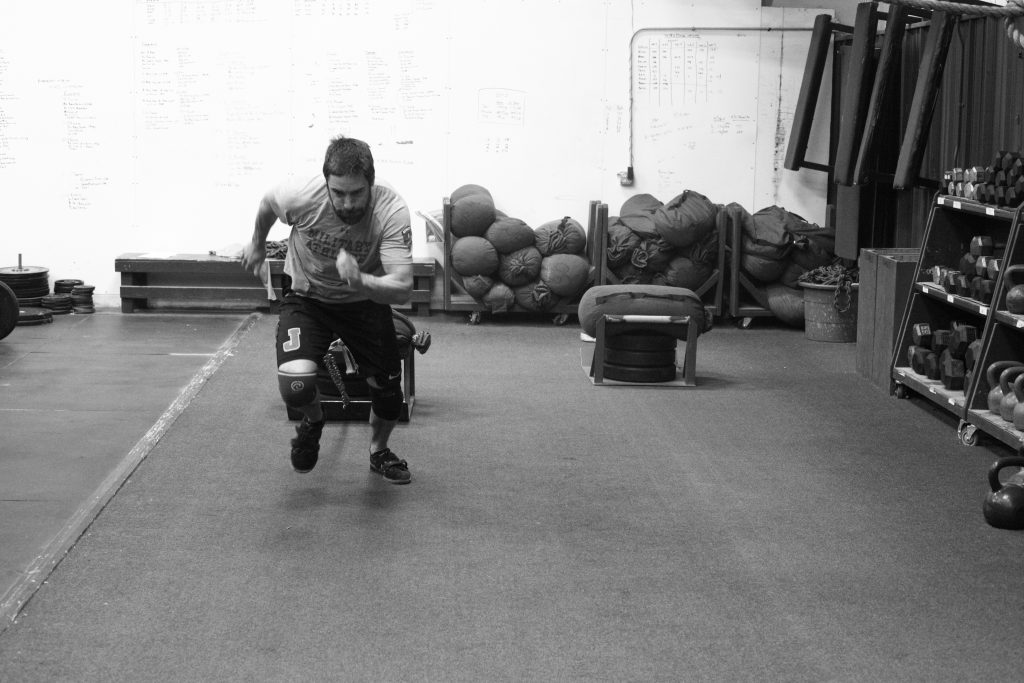By Rob Shaul
BLUF
Remote MTI Lab Rats showed nearly slight increases in leg strength and work capacity following an intense training cycle which featured forward sled pull intervals, three times per week.
- Front Squat 1RM: +8.78%
- Hinge Lift: 5.12%
- Prone to Sprint Reps: 3.80%
Background
Sled pulls and pushes are popular exercises in strongman training, football strength and conditioning, and sprint-speed training.
There is limited research available on the effects of sled pulls on sprinting speed, but none that we could find on the overall conditioning effects of high volume, interval-based sled pushes, and/or pulls. Many college weight rooms and strongman competitors swear by the strength and work capacity conditioning power of sled pushes/pulls, but to our knowledge, this has never been actually quantified.
We were especially interested in the potential for sled pushes/pulls to increase lower body strength. MTI’s evolving programming for older athletes (40+) is hesitant to prescribe the traditional heavy squatting and lunging to develop leg strength out of concern about prematurely causing knee arthritis. As well, for many older athletes, myself included, pain from knee, hip and ankle issues make loaded squats and lunges increasingly intolerable.
Without loaded squatting and lunging movements, the exercise prescription to increase lower body strength is limited, primarily to MTI’s bodyweight Leg Blaster complex, and similar bodyweight based training.
Sled drag/push intervals could offer another option to train lower body strength for not only older athletes, but all athletes.
In addition, sled drag/push intervals have a significant work capacity element – often bringing athletes to threshold, if not, panic breathing.
However, a significant programming issue with sled pulls/drags is the sled and the sliding surface greatly affect the friction and thus the difficulty of the effort. This makes it difficult for strength coaches to program load-based sled pushes/pulls for athletes.
We’re hoping an interval-based system, with a prescribed level of exertion, while not perfect, can lead to an effective way to program and progress sled pushes and drags.
Going into this mini study, we hoped to learn ….
- The effectiveness and computability of an exertion prescribed, and interval-based, sled push/pull programming methodology.
- The fitness effects of sled pushed/pulls on endurance, lower body strength, and overall work capacity.
Mini-Study Design
We advertised for remote lab rats with access to a sled and space to push/pull, and designed a 3-week training cycle bookended by a lower body strength and work capacity assessment:
- 1RM Front Squat
- 1RM Hinge Lift
- Max Rep 40-Foot Prone to Sprints in 3 Minutes
Between assessments, all the lab rats the same 3-week training cycle. Importantly, the programming did not include any additional lower body strength or work capacity training beyond the sled pull intervals. Here was the weekly schedule:
- Monday: Sled Pul Intervals
- Tuesday: Upper Body Strength, Chassis Integrity
- Wednesday: Sled Pul Intervals
- Thursday: Upper Body Strength, Chassis Integrity
- Friday: Sled Pul Intervals
- Saturday: Rest or Outdoor Recreation
- Sunday: Rest or Outdoor Recreation
Significantly for this study:
- Sled work was limited to forward sled pulls only
- Deployed 30 second work, 60 second rest, sled pull intervals. Athletes were instructed to adjust the sled pull weight as needed to aim for a hard, slow, jog, 30-second pull.
- The interval format (30 sec work, 60 sec rest) was not changed during the duration of the cycle, but the number of intervals was progressed, from 8 rounds at the beginning to 14 rounds at the end. It total duration, the sled pull efforts progressed from 12 minutes to 21 minutes.
Results and Discussion
See the chart below for results from this cycle:
The equipment restrictions limited the number of lab rats for this mini study – although a sled itself, was not needed. Some lab rats chose to pull a sandbag rather than a sled.
Because just 4 lab rats completed the programming, the results are not statistically significant in the academic sense. But from a programming perspective in line with MTI’s Mission Direct Research approach, the results are encouraging.
Overall, leg strength improved. I could be fairly argued that the athletes would have increased their 1RM Front Squat and 1RM Hinge Lift results simply by taking the assessment twice – i.e. just being familiar with the assessment could increase results. However, even if sled pulls had minimal impact on increasing leg strength, the results show that doing 3 weeks of sled pulls, 3x/week, at least maintained leg strength, which is significant.
I was somewhat surprised an disappointed in the work capacity re-assessment results as I would have expected sled pulls to significantly increase work capacity
Next Steps
This Mini-Study results are encouraging and offer forward sled pulls prescribed in a simple exertion based, interval progression as another way to train and maintain lower body strength for athletes.
The sled work in this mini-study was limited to forward sled pulls. Next, we need to test (1) backward sled pulls and a combination of forward and backward sled pulls.
As well, experiment with intervals … i.e. would a 15/60 or 15/30 interval do better at increasing strength?
Questions? Email coach@mtntactical.com
Comments? Please enter your comment below.
You Might Also Like MTI’s Big24 Strength Training Plan


